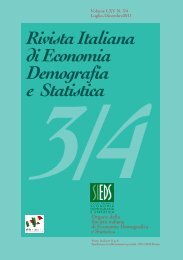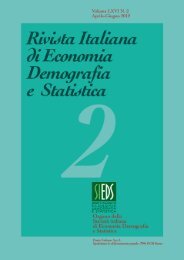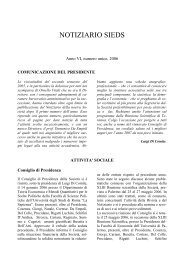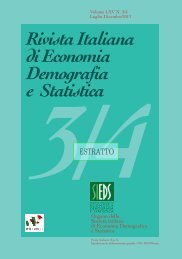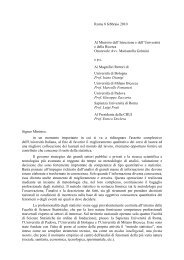rivista italiana di economia demografia e statistica - Sieds
rivista italiana di economia demografia e statistica - Sieds
rivista italiana di economia demografia e statistica - Sieds
You also want an ePaper? Increase the reach of your titles
YUMPU automatically turns print PDFs into web optimized ePapers that Google loves.
70<br />
Volume LXIII nn. 3-4 – Luglio-Dicembre 2009<br />
provenienti dal modello, ai fini <strong>di</strong> eventuali interventi <strong>di</strong> politica economica,<br />
appaiono piuttosto ragionevoli: i Paesi con effetto Quantità negativo dovrebbero<br />
incrementare la spesa sociale e i trasferimenti alle famiglie. Relativamente<br />
all’effetto Distribuzione, seppur residuale, emerge invece che nei Paesi dove è<br />
maggiore la platea dei beneficiari <strong>di</strong> trasferimenti governativi c’è maggiore<br />
probabilità <strong>di</strong> uscita.<br />
Riferimenti bibliografici<br />
Anderson D.A. e Aitkin M. 1985. Variance component models with binary response:<br />
interviewer variability. Journal of Royal Statistical Society Series B, vol. 47, pp 203-210.<br />
Gelman A. e Hill J. 2007. Data Analysis Using Regression and Multilevel/Hierarchical<br />
Models. Cambridge University Press.<br />
Goldstein H. 1995. Multilevel Statistical Models. Edward Arnold, London.<br />
Hox J.J. 1995. Applied multilevel analysis. TT-Publikaties, Amsterdam.<br />
Joe H. 2008. Accuracy of Laplace approximation for <strong>di</strong>screte response mixed models.<br />
Computational Statistics & Data Analysis, vol. 52 (issue 12), pp 5066-5074. Elsevier<br />
Science Publishers B. V., Amsterdam, The Netherlands.<br />
R Development Core Team. 2005. R: A language and environment for <strong>statistica</strong>l<br />
computing. R Foundation for Statistical Computing, Vienna, Austria.<br />
Snijders T. e Bosker R. 1999. An Introduction to Basic and Advanced Multilevel Modeling.<br />
Sage, London.<br />
SUMMARY<br />
This paper analyses the impact of some European countries’ policies in terms of<br />
monetary social transfers on the reduction of poverty risk in households with<br />
minors. Using micro data collected in Eu-silc 2006 (European Statistics on Income<br />
and Living Con<strong>di</strong>tions), we employ a two-level logistic regression model.<br />
It turns out an overall country effect, which could be splitted into two partitions:<br />
one due to <strong>di</strong>fferent policies relative to quantitative aspects (Quantity), the other to<br />
<strong>di</strong>stributive ones (Distribution). European countries with a greater positive effect<br />
on the exit from the poverty risk after transfers are the Nor<strong>di</strong>c and the Western<br />
ones; Me<strong>di</strong>terranean and Baltic ones have the opposite effect. Moreover, the<br />
Quantity effect is larger than the Distribution one.<br />
Generally speaking, the model stresses out that countries with a negative<br />
Quantity effect should increase social expen<strong>di</strong>ture and transfers to households;<br />
concerning the Distribution effect, although residual, in countries with the highest<br />
beneficiaries’ shares of social transfers there is a higher probability of exit.<br />
Andrea CUTILLO, ISTAT, Con<strong>di</strong>zioni e Qualità della Vita.<br />
Daniela LO CASTRO, ISTAT, Con<strong>di</strong>zioni Economiche delle Famiglie.<br />
Isabella SICILIANI, ISTAT,Con<strong>di</strong>zioni Economiche delle Famiglie.



